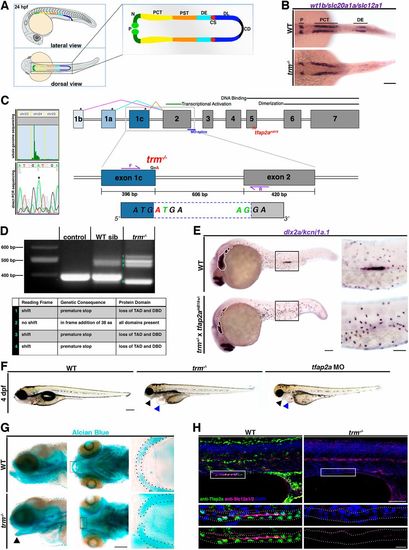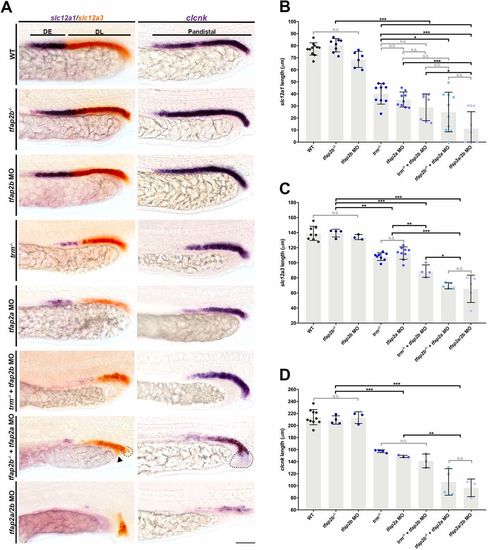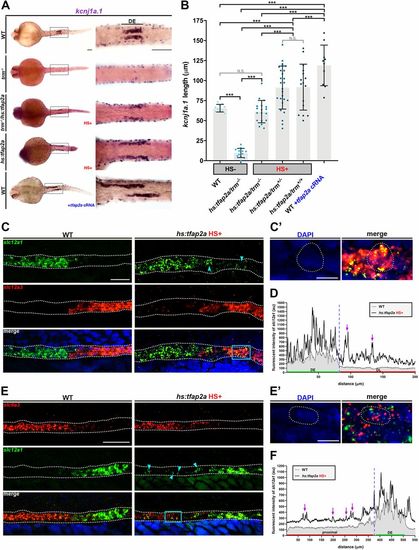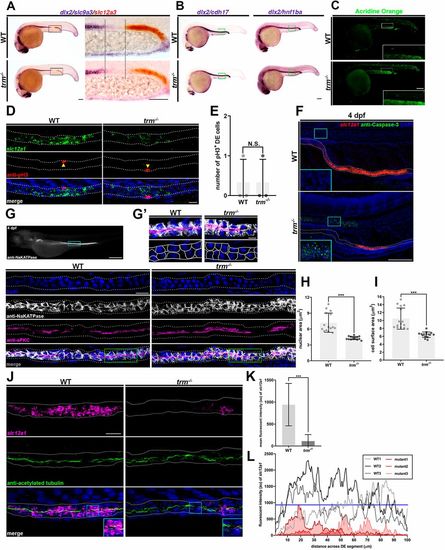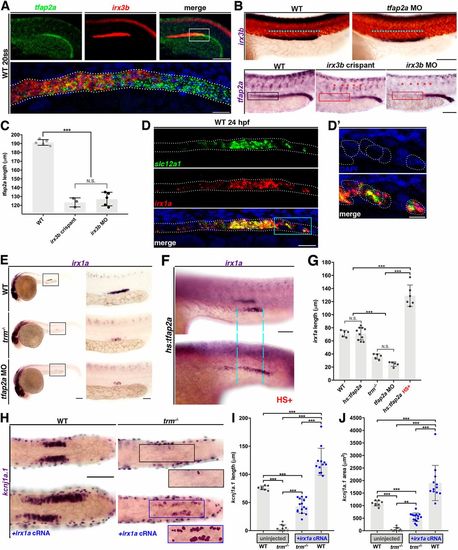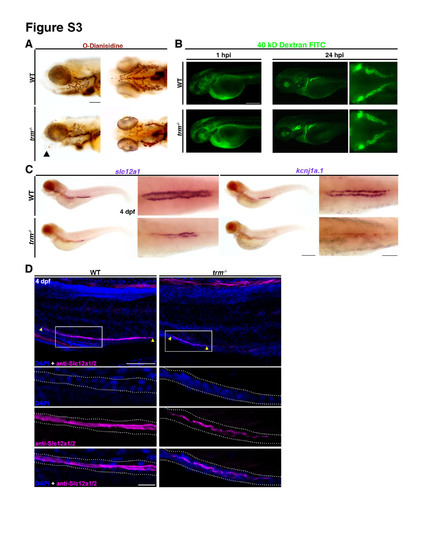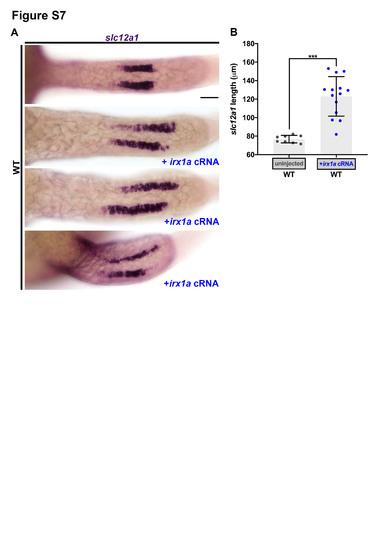- Title
-
Tfap2a is a novel gatekeeper of nephron differentiation during kidney development
- Authors
- Chambers, B.E., Gerlach, G.F., Clark, E.G., Chen, K.H., Levesque, A.E., Leshchiner, I., Goessling, W., Wingert, R.A.
- Source
- Full text @ Development
|
Forward genetic screen reveals tfap2a is necessary for nephrogenesis in the developing zebrafish pronephros. (A) Zebrafish pronephros schematic. P, podocytes; N, neck; PCT, proximal convoluted tubule; PST, proximal straight tubule; DE, distal early; CS, corpuscle of Stannius; DL, distal late; CD, collecting duct. (B) Whole-mount in situ hybridization at 24 hpf. Scale bar: 70 µm. (C) SNPtrack from whole-genome sequencing at chromosome 24, with G>A tfap2a mutation in trm−/−. Exon diagram: tfap2a spliceoforms (pink, cyan and orange); black asterisks indicate alternative start sites; location of MO (blue) and tfap2am819 lesion (red); conserved nucleotides (green), mutant nucleotides (red) and primer locations (purple). (D) RT-PCR with mutant bands 1-4 (green) and table of predicted consequences from sequence analysis. TAD, transcriptional activation domain; DBD, DNA-binding domain. (E) Whole-mount in situ hybridization with pharyngeal arches (white outlines) and DE (black box) indicated. Scale bars: 70 µm (left) and 35 µm (right). (F) trm mutants exhibit abnormal craniofacial cartilage (black arrowheads) and pericardial edema (blue arrowheads). Scale bar: 200 µm. (G) Alcian Blue staining, with gaping jaw (black arrowhead); black dotted lines trace Meckel's cartilage. Scale bar: 100 µm. (H) Immunofluorescence of Tfap2a (green) and Slc12a1/2 (magenta). White dots show the pronephros border. Scale bars: 50 µm (top), 10 µm (bottom). |
|
tfap2a and tfap2b are expressed in dynamic overlapping domains in developing nephrons, where tfap2a acts upstream of tfap2b. (A) Whole-mount in situ hybridization for tfap2a and tfap2b expression (purple), and smyhc1 expression (red). Black boxes indicate pronephros expression. Scale bar: 200 µm. (B) Fluorescent in situ hybridization for tfap2a (green) and tfap2b(red) in 10 ss (flat mount), 20 ss and 28 ss wild-type embryos (lateral views). White arrowheads indicate overlap. Scale bar: 70 µm. (C) Fluorescent in situ hybridization for pax2a (green), tfap2a (red) and tfap2b (red) in 10 ss wild-type embryos. White boxes outline the region shown in more detail in the bottom panel. Cyan circles indicate example cells co-expressing pax2a and tfap2a or tfap2b. White dots indicate the renal progenitor field border. Scale bars: 100 µm (top) and 10 µm (bottom). (D) Fluorescent in situ hybridization for slc12a1 (magenta) and tfap2a (green). White box indicates the area shown in more detail below. Scale bars: 70 µm (top) and 10 µm (bottom). (E) Whole-mount in situ hybridization for tfap2b. Arrowhead indicates hindbrain. Scale bars: 100 µm (left) and 70 µm (right). (F) Absolute length quantification of tfap2b. (G) Whole-mount in situ hybridization for tfap2a. Scale bars: 70 µm. (H) Absolute length quantification of tfap2a. n≥3. Measurements compared using unpaired t-tests. Data are mean±s.d. ***P<0.001; N.S., not significant. EXPRESSION / LABELING:
PHENOTYPE:
|
|
tfap2a and tfap2b function redundantly to activate distal nephron solute transporter signature. (A) Whole-mount in situ hybridization for slc12a1 (DE, purple), slc12a3 (DL, red) and clcnk (pan-distal, purple) at 24 hpf. Black bars indicate wild-type marker domains. Black dots encircle cysts in the duct; black arrowhead indicates incomplete fusion of cloaca. Scale bar: 35 µm. (B-D) Absolute length quantifications of (B) slc12a1, (C) slc12a3 and (D) clcnk. n≥3. Measurements compared by ANOVA. Data are mean±s.d. *P<0.05; **P<0.01; ***P<0.001; N.S., not significant. EXPRESSION / LABELING:
PHENOTYPE:
|
|
tfap2a is necessary and sufficient to drive the DE gene expression program. (A) Whole-mount in situ hybridization with the black bar indicating the kcnj1a.1 domain. Scale bars: 70 µm. (B) Absolute quantification of domain length per nephron. n≥10. Measurements compared by ANOVA. Data are mean±s.d. ***P<0.001; N.S., not significant. HS+, heat-shock; HS−, no heat-shock. +tfap2a cRNA (blue) indicates RNA microinjection. (C) Fluorescent in situ hybridization for indicated markers. Scale bar: 20 µm. Cyan arrowheads identify ectopic slc12a1 in an adjacent segment. Cyan box indicates area shown in C′. (C′) DAPI (left) and merge (right). White dots outline a cell co-expressing slc12a1 and slc12a3. Scale bar: 5 µm. (D) Fluorescent intensity plot of slc12a1 expression in individuals from C. Blue dashed line demarcates wild-type segment boundary location. Purple arrows indicate ectopic slc12a1 in an adjacent segment and correlate with ectopic slc12a1 identified by cyan arrows in C. (E) Fluorescent in situ hybridization for indicated markers. Scale bar: 35 µm. Cyan arrowheads identify ectopic slc12a1 in an adjacent segment. Cyan box indicates the area shown in E′. (E′) DAPI (left) and merge (right). White dots outline cell co-expressing slc9a3 and slc12a1. Scale bar: 5 µm. DAPI (blue) labels nuclei. (F) Fluorescent intensity plot of slc12a1 expression in individuals from E. Blue dashed line represents the wild-type segment boundary. Purple arrows indicate ectopic slc12a1 in an adjacent segment and correlate with ectopic slc12a1 (cyan arrowheads) in E. White dotted lines throughout demarcate the pronephros; all embryos are at 24 hpf. EXPRESSION / LABELING:
PHENOTYPE:
|
|
tfap2a is essential for the induction of terminal differentiation in the distal nephron. (A,B) Whole-mount in situ hybridization for indicated markers. Black dotted lines indicate the area with DE progenitors. Green boxes specify continuous expression of tubule markers in DE. Scale bars: 70 µm. (C) Acridine Orange staining. The white box indicates the optical zoom of a distal nephron. Scale bar: 70 µm. (D) Fluorescent in situ hybridization with immunofluorescence. Yellow arrowheads represent pH3+/slc12a1+ cells. White dots outline the pronephros. Scale bar: 10 µm. (E) Quantification of pH3+ DE cells. (F,G) Fluorescent in situ hybridization with immunofluorescence at 4 dpf. Cyan boxes indicate notochord in insets. Scale bar: 100 µm. (G) Cyan box indicates regions shown underneath. Gray dots border tubule. Green boxes indicate regions featured in G′. Scale bar: 10 µm. (G′) Optical zoom of regions highlighted in G. Bottom panels depict the strategy used to trace Na,K-ATPase expression to score cell morphology. Scale bar: 5 µm. (H) Quantification of nuclear area. (I) Quantification of cell surface area. (J) Fluorescent in situ hybridization with immunofluorescence. White dots line nephron limits. Cyan box indicates inset (optical zoom). Scale bar: 10 µm. (K) Quantification of mean fluorescent intensity (au) from three mutant and three wild-type samples across a 100 µm distance within the DE. (L) Fluorescent intensity plot of three wild-type individuals (grayscale) and three mutant individuals (red). Blue line indicates the threshold value (au) of wild-type slc12a1 transcripts. n≥3. ***P<0.001; N.S., not significant. Data are mean±s.d. Cell counts, area measurements and fluorescent intensity (au) analyzed using unpaired t-tests. PHENOTYPE:
|
|
tfap2a interplays with the Iroquois homeobox genes irx3b and irx1a during nephrogenesis. (A) Fluorescent in situ hybridization for indicated markers. White box indicates the area shown in the panel below. Scale bars: 70 µm (top) and 10 µm (bottom). (B) Whole-mount in situ hybridization for indicated markers. Cyan dots indicate the irx3b expression domain. Black box indicates the presence of tfap2a transcripts; the red box indicates their absence. Red asterisks indicate disrupted tfap2a expression in neural crest streams. Scale bars: 70 µm. (C) tfap2a expression domain quantification (n≥3). Measurements compared by unpaired t-test. Data are mean±s.d. ***P<0.001. (D) Fluorescent in situ hybridization for indicated markers. Cyan box indicates the region shown in D′. Scale bar: 10 µm. (D′) Optical zoom to highlight the area of interest; DAPI (top); merge (bottom); dotted lines encircle dually expressing slc12a1+ irx1a+ cells. Scale bar: 5 µm. (E,F,H) Whole-mount in situ hybridization for indicated markers. Scale bars: 75 µm in E; 35 µm in F. (G,I) Domain length quantifications. (H) Insets show trace of kcnj1a.1+ (solid purple) for area quantifications in J. Scale bar: 75 µm. (J) kcnj1a.1 area quantification per nephron. Measurements compared using ANOVA. Data are mean±s.d. **P<0.01; ***P<0.001; N.S., not significant. EXPRESSION / LABELING:
PHENOTYPE:
|
|
Additional phenotype analysis of trm-/- mutant embryos. A. O-dianisidine staining of craniofacial vasculature in WT and trm-/- at 4 dpf. Abnormal cartilage (black arrowhead). Scale bar = 100 μm. B. Kidney function assay was performed by injecting 40 kD Dextran FITC into the circulation of 2 dpf WT and trm-/- larvae. Images were collected 1-hour post injection and 24-hours post injection. Right panel: nephron tubules labeled with green fluorescence indicate endocytosis of Dextran. Scale bar = 150 μm. C. WISH DE markers (slc12a1 and kcnj1a.1) in WT and trm-/-. Scale bars = 200 μm, 50 μm. D. IF for Slc12a1/2 (magenta) in WT and trm-/-. Yellow arrowheads signal the start and end of Slc12a1 pronephric expression. White boxes indicate 60x mag (below). Scale bars = 100 μm, 10 μm. |
|
tfap2b MO splice efficacy verification through RT-PCR analysis, and phenotyping of tfap2b morphants and mutants. A. tfap2b exon map: tfap2b MO-splice (red) targets the 3’ end of exon 4. RT-PCR primers are situated within exon 4 and exon 5 (green arrows). tfap2bsa10090 lesion is positioned at the end of the intron before exon 4, blocking an essential splice site (blue). B. RT-PCR gel reveals larger product size in the MO lane, indicating disrupted splicing. 1 = WT band, 2 = MO band. C. Table of sequencing results for each band. D. Predicted WT and tfap2b MO amino acid sequences. Inclusion of intron 4-5 causes premature stop codon (red), and a predicted truncated protein in tfap2b MOs. E. Live imaging. Scale bar = 70 μm F. RT-PCR analysis of tfap2b transcripts in tfap2bsa10090 mutants. 1 = WT band, 2,3,4 = mutant bands. G. Table of sequencing results for each PCR band. H. Predicted WT and tfap2bsa10090 amino acid sequences. I. WISH for tfap2a in tfap2b morphants. Scale bars = 100 μm. J. Quantification of tfap2a domain length for WT and tfap2b morphants. |
|
Global overexpression of tfap2a expands kcnj1a.1 and slc12a3 distal tubule markers within the pronephros. A. WISH indicated markers. WT and three different hs:tfap2a underwent heat-shock treatment at 8ss and were fixed at 24 hpf. Green arrowheads label kcnj1a.1+ cells expanding in either the proximal or distal direction upon tfap2a overexpression. Scale bar = 35 μm. B. WISH to assay for slc9a3 (red, pan proximal) and slc12a3 (purple, distal late) expression in 24 hpf WT and hs:tfap2a animals subjected to heat-shock at the 8ss. Black box indicates region highlighted by inset. Black arrowheads identify individual distal slc12a3+ cells invading the slc9a3+ pan proximal domain. Scale bar = 150 μm C. Penetrance graph illustrating percentage of hs:tfap2a embryos (treated with heat-shock at the 8ss) that exhibit normal or expanded kcnj1a.1 (light purple) and slc12a3 (dark purple) phenotypes. n = 76 samples were scored for changes in kcnj1a.1 expression, and n = 24 samples were scored for changes in slc12a3 expression. Grey indicates hs:tfap2a animals counted that did not exhibit expanded distal marker phenotypes. |
|
trm-/- mutant embryos exhibit normal proximal nephron segment pattern formation but have abrogated corpuscle of Stannius formation. A. WISH to evaluate proximal convoluted tubule (slc20a1a) and proximal straight tubule (trpm7) in WT and trm-/- at 24 hpf. Black arrowheads indicate the start and end of slc20a1a expression. Scale bar = 50μm. B. Quantification of absolute . lengths of slc20a1a expression. C. Quantification of absolute lengths of trpm7 expression. n = 3 for each control and test group. Measurements were compared by unpaired t-test. Data are represented as ± SD. N.S. = not significant. D. WISH to assess corpuscle of Stannius (stc1) development in WT and trm-/- at 48 hpf. Black line indicates stc1 expression domain. Scale bar = 20 μm. |
|
irx1a overexpression drives slc12a1 expansion. A. WISH showing expanded slc12a1 expression domain in 3 different animals injected with irx1a cRNA as compared to wild-type uninjected control. Scale bar = 35 μm. B. Quantification of absolute lengths of slc12a1 stain per nephron. n ≥ 7 for each control and test group. Measurements were compared by unpaired t-test. Data are represented as ± SD. ***p < 0.001. |
|
Overexpression by irx1a cRNA injection causes the formation of ectopic eye structures. A. Live image of WT embryo injected with 80 pg of irx1a cRNA. Purple arrowhead indicates ectopic eye structure. Scale bar = 50 μm. B. Penetrance graph illustrating the frequency of ectopic eyes upon irx1a overexpression. A total of 148 irx1a cRNA injected animals were scored for number of eyes. Grey = two eyes, Purple = 3 eyes. |

